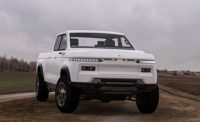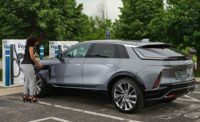For decades, batteries have powered everything from toys and toothbrushes to personal electronics and power tools. But, that’s just scratching the surface. During the next decade, advanced batteries will be mass-produced for a wide variety of new applications on land, sea and air.
Battery power is projected to become the backbone of renewable energy systems, such as micro grids, solar panels and wind turbines. The technology will store electrical energy that can later be converted back into electricity when needed, such as during peak demand periods. Between 2013 and 2018, energy storage projects throughout the United States increased by 174 percent.
Traditional lead-acid batteries are popular for this market, because of factors such as cost, recycling, safety and reliability. But, as lithium-ion batteries become more economical to produce, they are being used for more stationary applications.
On water, batteries are in demand to power hybrid-electric ferries, fishing boats, tugboats and other types of small commercial vessels, which are responsible for emitting large amounts of greenhouse gases.
Hybrid-electric propulsion technology is also one of the biggest trends in the aerospace industry today. In fact, the topic of electrification dominated the recent Paris Air Show.
The electric vertical-takeoff-and-landing segment is booming, with R&D activity ranging from startups to industry giants such as Airbus and Boeing. A handful of all-electric, manned aircraft have already completed successful test flights, while many other planes are in various stages of development. Unmanned drones also depend heavily on battery power.
Automotive Applications
However, all those efforts pale in comparison to what’s happening in the automotive industry, which is considered to be the crown jewel of battery applications. The market is developing rapidly, the necessary infrastructure is becoming more available and costs are becoming competitive with internal combustion engine equivalents.
Global sales of electric vehicles are expected to grow at a cumulative annual rate of 32 percent during the next six years, reaching nearly 11 million vehicles in 2025. And, by 2040, more than 55 percent of automobiles will be powered by batteries.
Better charging infrastructure, increasing vehicle range and lower battery cost will spur future sales growth. But, mass-production is critical. Batteries require a host of assembly technologies, including dispensing
equipment, leak testers, robots and ultrasonic welders.
Automotive engineers around the world are scrambling to develop electric vehicles and companies are pouring billions of dollars into next-generation battery manufacturing efforts. In Europe, automakers are attempting to roll out a wide variety of hybrid and fully electric cars by next year to meet strict new mandates on greenhouse-gas emissions.
By 2023, Ford Motor Co. plans to build 100,000 battery-powered vehicles a year using technology developed by Volkswagen AG, which is gearing up to mass-produce a small electric car called the ID.3. One of Ford’s models will be an all-electric version of its best-selling F-150 pickup truck. Ford also recently invested $500 million in a start-up company called Rivian, which plans to launch a line of electric pickup trucks and sport utility vehicles (SUVs) that will be assembled in Normal, IL.
Through its luxury brands such as Audi and Porsche, Volkswagen plans to unveil 30 battery-electric vehicles over the next six years as part of a $9 billion effort. In fact, the automaker claims that 40 percent of the vehicles it sells a decade from now will be battery powered. To meet that ambitious target, VW is building a $1 billion battery factory in Salzgitter, Germany, and is investing in several startup companies.
Over the next three years, General Motors plans to unveil more than 20 electric vehicles, while Daimler expects to introduce 10 battery-powered cars. Toyota Motor Co. claims that 50 percent of its sales will be comprised of hybrid-battery models by 2025. It is currently developing an electrified platform that will support six variations ranging from large SUVs to compact sedans.
Other vehicles in the works include everything from battery-powered Jeeps to an all-electric Rolls-Royce.
In addition to automobiles, batteries are increasingly being used to power buses, small delivery trucks, motorcycles, tractors and other types of commercial and off-road vehicles. Engineers at Daimler and Volvo are even developing heavy-duty electric-powered trucks that will compete against a vehicle being developed by Tesla Inc.
New Factories
To support all of that activity, new battery factories are cropping up everywhere these days.
“During the last five years, battery manufacturing has scaled up and cost has come down dramatically,” says Alex Eller, senior research analyst at Navigant Research. “The amount of new factories being built today is unprecedented.”
“We’ve seen a dramatic increase in projects recently,” adds Thomas Parker, automotive market sales manager for leak detection tools at Inficon Inc. “More automakers are setting up battery pack production lines.
“Many suppliers are also eager to get into the battery business today,” notes Parker. “For instance, we’re seeing companies that traditionally made condensers, evaporators, hoses and tubing explore new opportunities to mass-produce thermal management systems that cool batteries.”
Most battery R&D and manufacturing activity in the United States is based in either Detroit or Silicon Valley. However, one of the most talked about factories is Tesla’s $5 billion “gigafactory” (a term coined by Elon Musk to describe a facility capable of mass-producing batteries to generate gigawatt-hours of energy) in Sparks, NV.
As part of a joint-effort with Panasonic, the large facility mass-produces both battery cells and battery modules. Only about 30 percent of the factory is currently built, but it already employs more than 6,000 people on more than 10 production lines.
Tesla claims that the facility will reduce the per-kilowatt-hour cost of its lithium-ion battery packs by more than 30 percent, which will in turn drive down the cost for its electric vehicles. At full capacity, the automated facility will employ up to 20,000 people.
LG Chem Power Inc., which supplies automakers such as General Motors and Volkswagen, also operates a state-of-the-art factory in Holland, MI. SK Innovation, a supplier to automakers such as Daimler, Hyundai and Kia, is building a gigafactory near Atlanta, in addition to another large plant in Hungary that will supply European automakers. And, Akasol AG is investing $40 million in a new plant near Detroit that will mass-produce lithium-ion batteries for commercial vehicles.
All of those factories produce battery cells and battery modules. Cells consist of anodes, cathodes, electrolytes, binders and separators that are processed into cylindrical, square or rectangular shapes. Module production refers to the integration of thousands of single cells into larger packages that contain electronic management components.
Battery pack assembly is the process of integrating modules into metal or carbon-fiber composite enclosures that incorporate power, charging and temperature management features. Key components include battery modules, cooling systems, power electronics and battery management systems.
Most automakers prefer to keep this process in-house. For instance, Ford operates a battery pack assembly plant in Rawsonville, MI, while GM has a 479,000-square-foot facility in Brownstown, MI.
“Each automaker has its own proprietary battery pack design, so there’s wide variation throughout the industry,” says Eller. “Most automakers buy battery cells and modules from companies such as Contemporary Amperex Technology, LG Chem Power or Samsung SDI.”
“There’s a lot of difference in battery pack architectures,” explains Parker. “Most manufacturers want to control this process. They consider it to be proprietary, just like the engine and drivetrain of a traditional gas-powered vehicle. Automakers believe the battery pack is a place where they can differentiate themselves and leverage profit margins.”
According to McKinsey & Co., producing an electric car currently costs an average of $12,000 more than a traditional vehicle. But, production costs are dropping as volumes increase. Parity is expected to be achieved within the next five years due to increasing use of automation.
“The amount of automation used in battery manufacturing today is phenomenal compared to what was available five to 10 years ago,” says Matthew Keyser, vehicle electrification group manager at the U.S. Department of Energy’s National Renewable Energy Laboratory.
“Lithium is still king and will be for the foreseeable future until some of the newer battery technologies, such as lithium-sulfur and solid-state chemistries, are commercially available,” claims Keyser. “Lithium-ion batteries should remain popular for at least the next 10 years.
“Today, engineers are trying to improve the energy density of cells to increase range between recharging,” Keyser points out. “The goal is to make them more compact and generate the same amount of energy in less volume and mass.”
Assembly Challenges
Battery assembly requires a variety of production processes and equipment, including adhesive bonding and sealing, laser welding, leak testing, screwdriving and ultrasonic welding. To reduce costs and boost throughput, robots and other types of automation are essential.
“Joining continues to be one of the biggest challenges for cell and battery pack assemblers,” says Mitch Matheny, engineering manager at EWI. “Manufacturers are dealing with new materials and new joint designs that require a fresh look at the [assembly] process. [We have] seen a staggering increase in the amount of welding research and development we perform related to cells and battery packs.
“The top three processes are laser, resistance and ultrasonic welding,” explains Matheny. “Lasers are fast, non-contact, single-sided, and if you want to change your weld geometry you may be able to simply modify the path of the laser head. However, lasers may struggle with thin materials, gaps and back reflection from materials like copper.
“Resistance welding relies on the electrical resistance of a material to generate heat for a weld, which does not lend itself well to joining low-resistance materials like aluminum and copper,” notes Matheny. “But, using resistance welding to create solid-state welds in copper and aluminum is common practice because the temperature does not need to reach the melting point of the material.
“Ultrasonic metal welding is well suited for joining the thin, soft, thermally conductive materials used in cells and battery packs,” says Matheny. “So naturally, demand has increased.”
“Ultrasonic welding has become a very prominent process for joining dissimilar materials, such as copper, nickel and aluminum, which are the materials frequently used to make battery foils, wires and terminals,” adds Janet Devine, president of Sonobond Ultrasonics.
“Ultrasonic welders quickly and reliably weld battery foils, foils to terminals and wires to terminals,” Devine points out. “In addition, the trend to increase the power capacity of electric vehicle batteries and charging stations necessitates the use of higher power welders capable of welding much larger wire bundles and terminals.”
“There are many advantages in using ultrasonic welding,” claims Home Mojalm, special systems sales manager at Telsonic Solutions LLC. “It generates very little heat and this heat generation is very localized. Therefore, it does not affect the chemistry of the cell. Tool life is often far superior to other joining techniques, which translates to less cost and downtime.”
Multiple fasteners are often used to produce battery enclosure assemblies. “This is necessary to ensure robustness, because many battery packs double as structural components of vehicles,” says Boris Baeumler, applications engineer at DEPRAG Inc.
“The typical battery assembly enclosure consists of multiple components, such as a base plate and a variety of different structural ribs that separate battery cells and modules,” explains Baeumler. “Most enclosures use aluminum parts that are assembled with robots. Manufacturers use our FlowForm screwdriivng technology, because it provides additional joint strength, avoids gaps that can allow moisture to penetrate, and eliminates the need for secondary processes such as drilling.”
“Adhesives and sealants also play an important role in all stages of battery manufacturing, including cell production, module production and battery pack assembly,” says Tim Campbell, product line manager for the automotive and sealant equipment divisions of Nordson Sealant Equipment. “Applications include bonding epoxies and silicones to create structural rigidity or keep a component in place; sealing to prevent dust, humidity and moisture from leaking in; and dispensing thermal materials to draw heat away from batteries.”
“Thermal conditions have enormous effects on the service life, recharging capacity and operational safety of lithium-ion batteries,” adds Brandon Zinn, lead lab engineer at Scheugenpflug Inc. “Very high temperatures can lead to severe or irreparable damage.
“To prevent this from happening, large quantities of heat-conducting paste are used,” explains Zinn. “However, due to their high viscosity and the high proportion of abrasive fillers, the application of these materials often poses a challenge, such as relatively low dispensing speeds.”
Growing interest in battery manufacturing has also spurred demand for automated leak testing equipment.
“Helium leak detection is used during the battery cell, module and pack production process,” says Inficon’s Parker. “Robotic sniffing is typically used to trace around electrical connections, covers and weld seams. In the past, this process was often done manually. Today, automation is widely used in the battery industry.”







